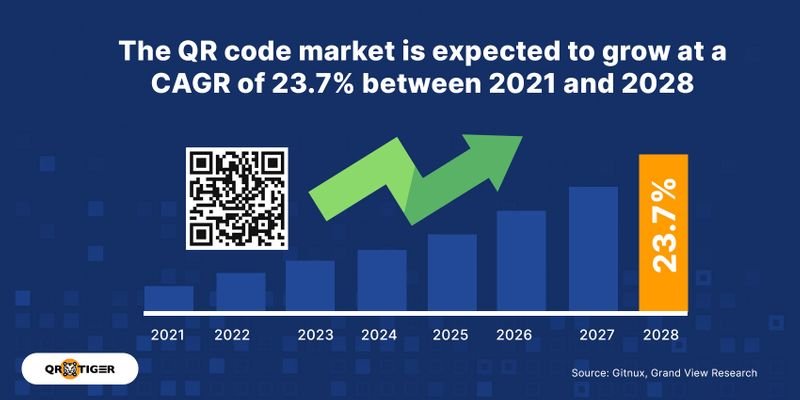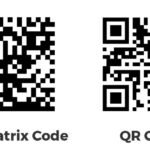QR codes have evolved from a pandemic-era necessity to an essential marketing infrastructure. With 59% of consumers scanning QR codes daily and QR-initiated journeys achieving a 37% average click-through rate, these black-and-white squares have become powerful engagement engines that connect physical and digital experiences.
For marketers in 2025, QR codes aren’t just about convenience—they’re about creating measurable, data-driven touchpoints that deliver real business results.
The Numbers Tell the Story: QR Code Growth in 2025

The data reveals explosive growth across every metric that matters to marketers:
Market Size and Projections
- The global QR code market was worth $1.5 billion in 2023 and is projected to reach $3.5 billion by 2033, with an 8.7% CAGR
- Global QR code scans reached 41.77 million in 2025, quadrupling from previous years
- QR code payments are projected to reach $3 trillion by 2025, up from $2.4 trillion in 2022
User Adoption and Engagement
- 89 million smartphone users in the US scanned QR codes in 2023, with projections exceeding 100 million by 2025
- 42.6% of US adult smartphone users are expected to scan QR codes by 2025, up from 37.5% in 2022
- 84% of smartphone users have scanned a QR code at least once, with 72% doing it monthly and 32% scanning weekly
Consumer Behavior Shifts
- 95% of businesses confirm QR codes help collect valuable first-party data
- 79% of businesses use dynamic QR codes to deliver personalized, context-aware interactions
- 79% of shoppers are more likely to buy a product with a scannable QR code that provides necessary information
How Marketers Are Using QR Codes in 2025

The sophistication of QR code marketing has matured dramatically. Today’s marketers are deploying codes across multiple touchpoints with strategic precision:
Multi-Channel Implementation
Marketers are implementing QR codes across email (47%), product packaging (46%), events (43%), print ads (40%), and in-store displays (40%). This multi-channel approach creates interconnected experiences that guide customers between digital and physical touchpoints.
Primary Use Cases
The most effective QR code campaigns in 2025 focus on:
- Promotional offers and coupons (51%)
- Event information (49%)
- Product details (45%)
- Video demos (37%)
What Drives Consumer Scans
Understanding consumer motivation is crucial for effective QR marketing:
- Exclusive content or information (39%)
- Discounts or promotional offers (33%)
- Contest entries (14%)
- Loyalty points (12%)
Industry Leaders in QR Code Adoption
Different industries are leveraging QR codes with varying degrees of success:
Retail Dominance
Retail has the most QR code scanning activity, with 42% of US shoppers scanning QR codes in retail stores. 54% of young shoppers use QR codes regularly, highlighting the technology’s appeal to younger demographics.
Food Service Revolution
QR code usage in fast food establishments has reached 41%, and 52% of restaurants in the US now use QR code menus. 33% of restaurant owners using QR codes report improved business.
Logistics and Supply Chain
83% of global logistics respondents say QR codes are essential for their operations, with studies showing that QR codes for inventory management reduce 30-50% of picking errors.
The ROI and Performance Reality
QR codes deliver measurable returns when implemented strategically:
Engagement Metrics
One retail client saw a 35% boost in conversions in three months by linking in-store displays to exclusive online offers through QR codes. The high-intent nature of QR scanning—it’s a decision, not a casual scroll—contributes to these strong performance metrics.
Data Collection Advantages
With third-party cookies dying, QR codes offer a transparent way to understand customer behavior at each interaction level. 95% of businesses gather valuable first-party data through QR codes.
Customization Impact
49% of marketers find the most value in adding a business logo to QR codes, while others prioritize custom colors (38%) and unique frames or patterns (13%). These visual enhancements build trust and create seamless brand experiences.
Overcoming Current Challenges
Despite the growth, marketers face several key barriers:
Consumer Understanding
55% of marketers say customers don’t understand how to use QR codes, while others cite QR code overload (47%), security concerns (36%), and poor placement (21%).
Analytics Limitations
85% face challenges integrating QR code data with other marketing metrics, and 79% cite tracking and attribution complexities as a top ROI challenge. While tracking unique users (54%), total scans (50%), time of scan (50%), and location (48%) is common, only a third monitor the post-scan journey (31%), and just 16% tie QR codes directly to revenue.
Security Concerns
29% of consumers want companies to ensure QR codes are safe and secure, particularly given the rise in QR code-based security threats.
Emerging Trends Reshaping QR Marketing
Dynamic Over Static
Static QR codes are fading out as dynamic QR codes dominate because they offer flexibility. 69% of marketers update QR code destinations at least monthly, highlighting the demand for agile campaign management.
AI Integration
Artificial intelligence is playing a major role in how QR codes are created and optimized, with platforms offering AI-generated QR codes that adjust designs automatically for scanability and test conversion rates.
Smart Packaging Evolution
The global smart packaging market is booming, with QR codes leading the way to deliver supply chain transparency, product origin data, and sustainability certifications directly to consumers. The smart packaging market’s revenue is projected to grow to $8.6 billion by 2025.
Augmented Reality Integration
QR codes play an instrumental role in making AR experiences available to users, with the global AR and VR market projected to grow from $22.12 billion in 2024 to $96.32 billion by 2029.
Demographics and Generational Differences
Understanding who scans QR codes helps marketers target effectively:
Age Distribution
Young adults aged 18–29 are most likely to scan marketing-related QR codes, but the age distribution is fairly even, with nearly half of 30–44-year-old consumers and 44% of those aged 45–64 using marketing QR codes.
Gender Split
57% of QR code users are female and 43% are male, which marketers should consider since women drive 70-80% of purchasing decisions.
Geographic Adoption
The US, UK, Canada, Mexico, Australia, Singapore, the Netherlands, and India have the highest rates of QR code creation. The US leads with significant market share, while India is the second-leading nation with 9.3% of global QR code scans.
Best Practices for QR Code Marketing Success
Based on 2025 data and successful implementations:
Strategic Integration
- Align QR codes with specific marketing objectives and ROI goals
- Integrate QR codes into overall marketing strategy to ensure no disconnect and confusion
- Use QR codes to support omnichannel marketing efforts
Design and Placement
- Create QR codes with logos to ensure consistent branding
- Ensure mobile optimization and test on both iOS and Android devices
- Place QR codes in easy-to-access areas with clear calls-to-action
Value Proposition
- Provide clear incentives for scanning (discounts, exclusive content, convenience)
- Ensure QR codes take customers to usable interfaces that add value
- Focus on solving real customer problems, not just technology implementation
Analytics and Optimization
- Use dynamic QR codes for tracking and real-time updates
- Track performance metrics including scans, unique users, timing, and location data
- Connect QR code data to broader marketing attribution models
Looking Ahead: The Future of QR Code Marketing
The trajectory is clear: QR codes have moved from emergency pandemic solution to permanent marketing infrastructure. We’re heading toward a time when “QR-ing” might be just as commonplace as “Googling”.
Key developments to watch:
- Continued integration with AI and machine learning for optimization
- Enhanced security measures to address consumer concerns
- Deeper analytics integration for better ROI measurement
- Expansion beyond marketing into core business operations
The Bottom Line
QR codes are no longer a new trend that brands could use to wow their customers. The cost-effectiveness, versatility, and ease of use of QR codes have made them an essential marketing asset for all organizations.
For marketers in 2025, the question isn’t whether to use QR codes—it’s how to use them strategically to create meaningful connections, gather valuable data, and drive measurable business results. With global QR code usage expected to grow by 22% by 2025, the brands that master QR code marketing now will have a significant competitive advantage in the years ahead.
The data is clear: QR codes aren’t just surviving the post-pandemic world—they’re thriving as essential tools for modern marketing success.


